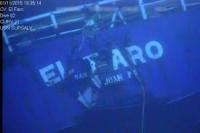 There are still almost as many questions as answers as to why the US flag ro/ro El Faro sank in Hurricane Joaquin last October with the loss of the 33 aboard. Today, the United States Coast Guard Marine Board of Investigation begins a formal investigation into the tragedy. The first hearing is being held in Jacksonville, FL, the port from which El Faro sailed on her final fatal voyage.
There are still almost as many questions as answers as to why the US flag ro/ro El Faro sank in Hurricane Joaquin last October with the loss of the 33 aboard. Today, the United States Coast Guard Marine Board of Investigation begins a formal investigation into the tragedy. The first hearing is being held in Jacksonville, FL, the port from which El Faro sailed on her final fatal voyage.
The current hearing will last through Friday and according to the Coast Guard press release will “focus on the pre-accident historical events relating to the loss, the regulatory compliance record of the EL FARO, crewmember duties and qualifications, past operations of the vessel and the Coast Guard’s Search and Rescue operations. During a later hearing session (date to be determined) the accident voyage, including cargo loading, weather conditions and navigation will be examined in detail. The National Transportation Safety Board, which conducted its own investigation, will fully participate in the Marine Board of Investigation hearings.”
The National Transportation Safety Board (NTSM) also recently announced that the search for El Faro‘s Voyage Data Recorder (VDR), the so-called “black box,” will resume next April and last about two weeks. In November, a team from the NTSB, onboard the Navy salvage tug USNS Apache, located the wreckage of El Faro but failed to locate the ship’s VDR. The VDR may provide more information as how and why the ship sank. The wreck was found at a depth of 15,000 or roughly a half mile deeper than the wreck of the Titanic.
The upper two decks of the deckhouse had been ripped off in the sinking and were found roughly one half mile from the rest of the ship. The VDR, which was mounted on the top of the bridge deck apparently had been torn off. After five days of searching using a Remotely Operated Vehicle (ROV), the NTSB “determined that the VDR could not be located.”
Senator Bill Nelson of Florida, however. urged the NTSB to continue the search, which now they have agreed to do. They will be using SENTRY, an autonomous underwater vehicle (AUV) that will be launched from the research vessel Atlantis, which is owned by the U.S. Navy and operated by the Woods Hole Oceanographic Institution (WHOI).
Unfortunately, SENTRY does not have the capacity to recover the VDR, if the they do succeed in locating it. Another mission will be undertaken if the VDR is found using a remotely operated vehicle capable of recovering the recorder.

El Faro’s Captain Davidson’s last email to management sought a route change:
http://www.cbsnews.com/news/el-faro-captain-sent-email-about-changing-route-day-before-ship-sank/
SVDRs have a DCU (Data Collecting Unit ) inside the wheelhouse or chartroom. The DCU contains the same info as the DRU (Data Recording Unit Capsule). Why no attempt to recover the DCU from the largely intact
wheelhouse?